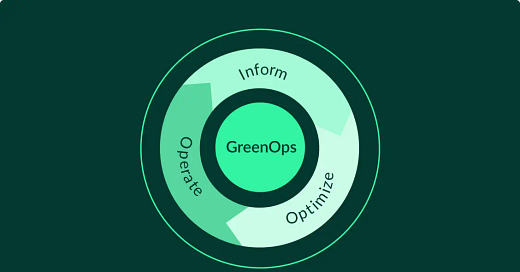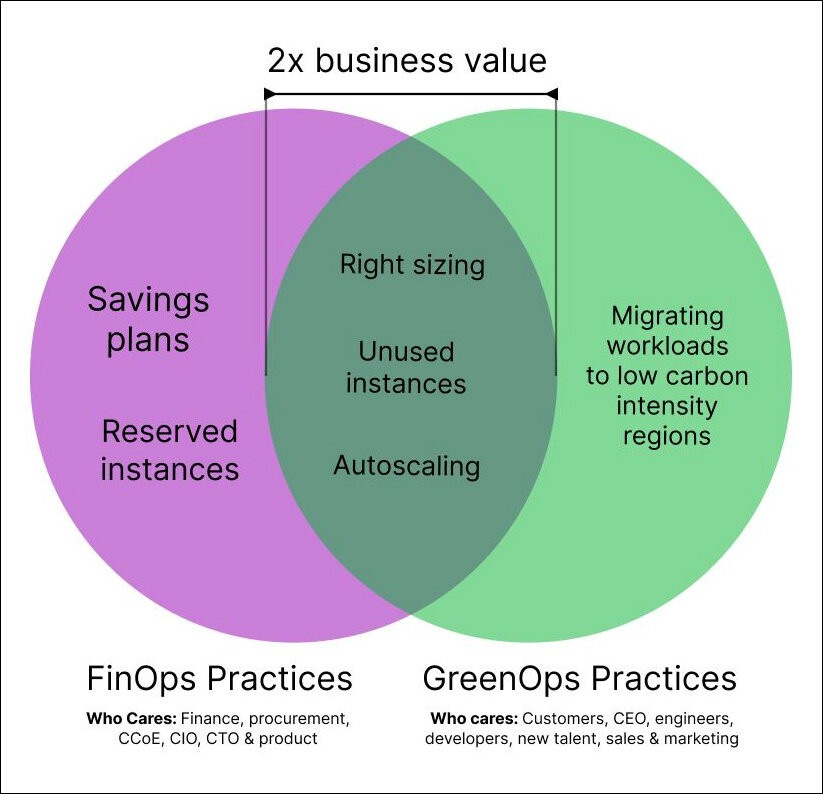GreenOps + FinOps: The Future of Cost-Effective and Sustainable IT
IT leaders know that cloud waste is costly—but do we really realise its full impact? Beyond wasted spend, inefficient cloud usage contributes significantly to carbon emissions and environmental degradation. With data centers projected to emit 2.5 billion metric tons of CO₂ by 2030, businesses must rethink their cloud strategies—not just for cost savings, but for sustainability.
This is where GreenOps and FinOps come in.
What Are GreenOps and FinOps?
• FinOps focuses on cloud financial management, ensuring that cloud spending aligns with business value.
• GreenOps extends FinOps by adding an environmental lens, ensuring cloud resources are cost-effective and energy-efficient.
Together, these frameworks help businesses optimise their cloud for both cost savings and sustainability.
Why GreenOps + FinOps Matter
1. Reduce Cloud Waste – Over 30-40% of cloud spending is wasted on idle or oversized resources.
2. Lower Carbon Footprint – Data centres consume enormous power and water, driving up emissions.
3. Improve Cost Efficiency – Eliminating wasteful cloud usage lowers operational expenses while maintaining performance.
4. Meet ESG and Sustainability Goals – Many companies now face pressure from regulators, investors, and customers to reduce their environmental impact.
The Environmental Cost of Cloud Computing
Cloud services run on massive data centres that require:
• High energy usage – Some hyperscale data centres consume as much electricity as small cities.
• Massive water consumption – U.S. data centres used 75 billion gallons of water in 2023 for cooling—equivalent to London’s water usage for four months.
• Significant carbon emissions – Many cloud providers still rely on fossil fuels, increasing global CO₂ emissions.
Offsetting emissions (e.g., planting trees) is not enough—businesses must eliminate unnecessary cloud waste at the source.
How GreenOps + FinOps Work Together
FinOps focuses on cost efficiency. GreenOps ensures sustainability. Combining both creates a cloud strategy that is financially and environmentally responsible.
1. Track Cloud Costs & Carbon Footprint
FinOps Approach – Use cloud cost monitoring tools to optimise spending.
GreenOps Approach – Leverage sustainability dashboards to track cloud energy usage and emissions.
Tools to use:
• Cloud Carbon Footprint – Tracks emissions from AWS, Azure, and GCP.
• Cloud provider sustainability dashboards – AWS, Azure, and Google Cloud offer carbon tracking tools.
2. Optimize Cloud Resource Allocation
FinOps Approach – Right-size workloads to reduce unnecessary costs.
GreenOps Approach – Move workloads to greener cloud providers and use low-power compute options.
Best practices:
Right-size compute, storage, and memory to match actual demand.
Autoscale workloads and schedule shutdowns for non-essential instances.
Move infrequent data to cold storage to minimise energy consumption.
3. Choose Sustainable Cloud Providers
FinOps Approach – Find cost-effective cloud providers.
GreenOps Approach – Select providers with renewable energy commitments and low Power Usage Effectiveness (PUE) scores.
Key considerations:
• Is the cloud provider carbon-neutral?
• Does it run on renewable energy?
• Does it offer sustainability reports?
4. Align Cloud Strategy with ESG Goals
FinOps Approach – Ensure cloud costs are linked to business value.
GreenOps Approach – Ensure cloud usage aligns with corporate sustainability commitments.
Business Benefits of GreenOps + FinOps
✔ Lower costs – Eliminating cloud waste reduces financial waste.
✔ Reduced emissions – Sustainable IT practices lower the company’s carbon footprint.
✔ Better compliance – Supports ESG (Environmental, Social, Governance) reporting and regulatory requirements.
✔ Competitive advantage – Companies with strong sustainability initiatives attract investors and customers.
The Future of Cloud is Cost-Efficient & Sustainable
IT teams already prioritise cost efficiency through FinOps. Adding GreenOps ensures cloud sustainability becomes just as important.
The question is no longer “Should we optimise cloud costs?” but rather “Can we afford to ignore the environmental impact of our cloud usage?”
Businesses that embrace GreenOps + FinOps today will lead the future of sustainable, cost-effective cloud computing.
#GreenOps #FinOps #CloudComputing #Sustainability #CloudWaste #ESG #ITOptimisation




